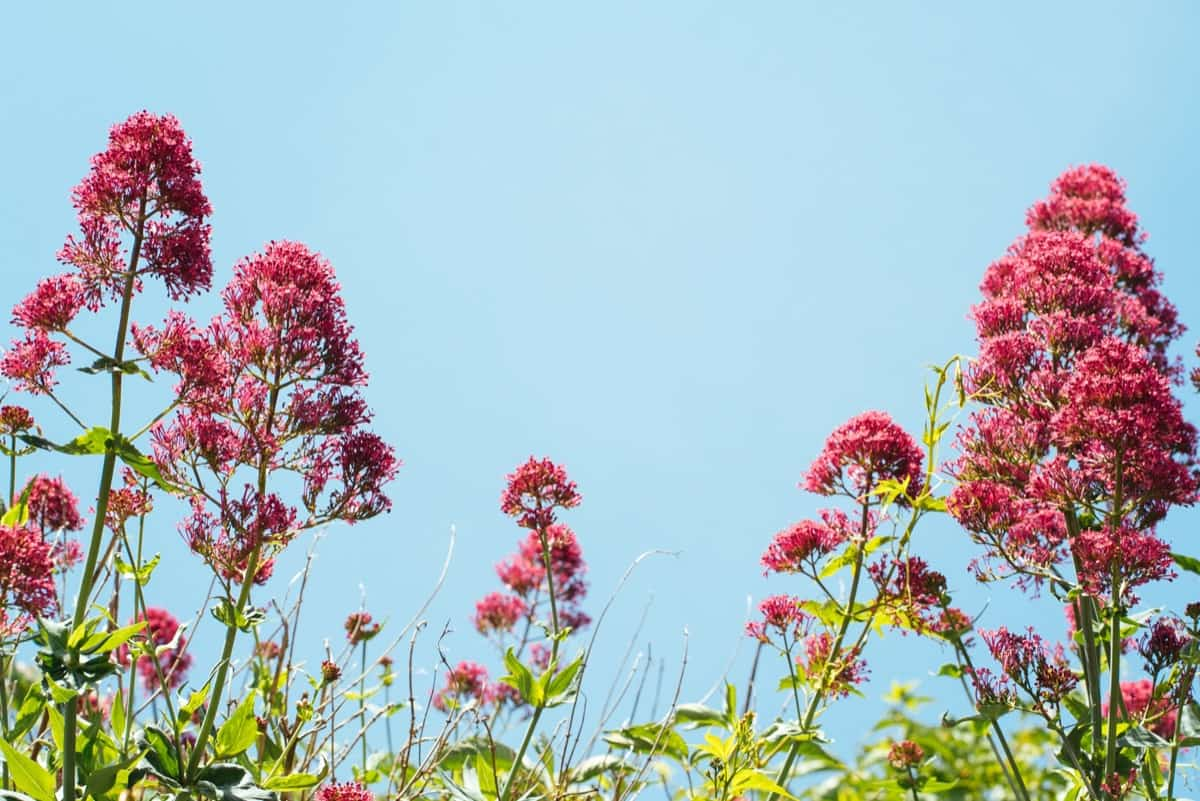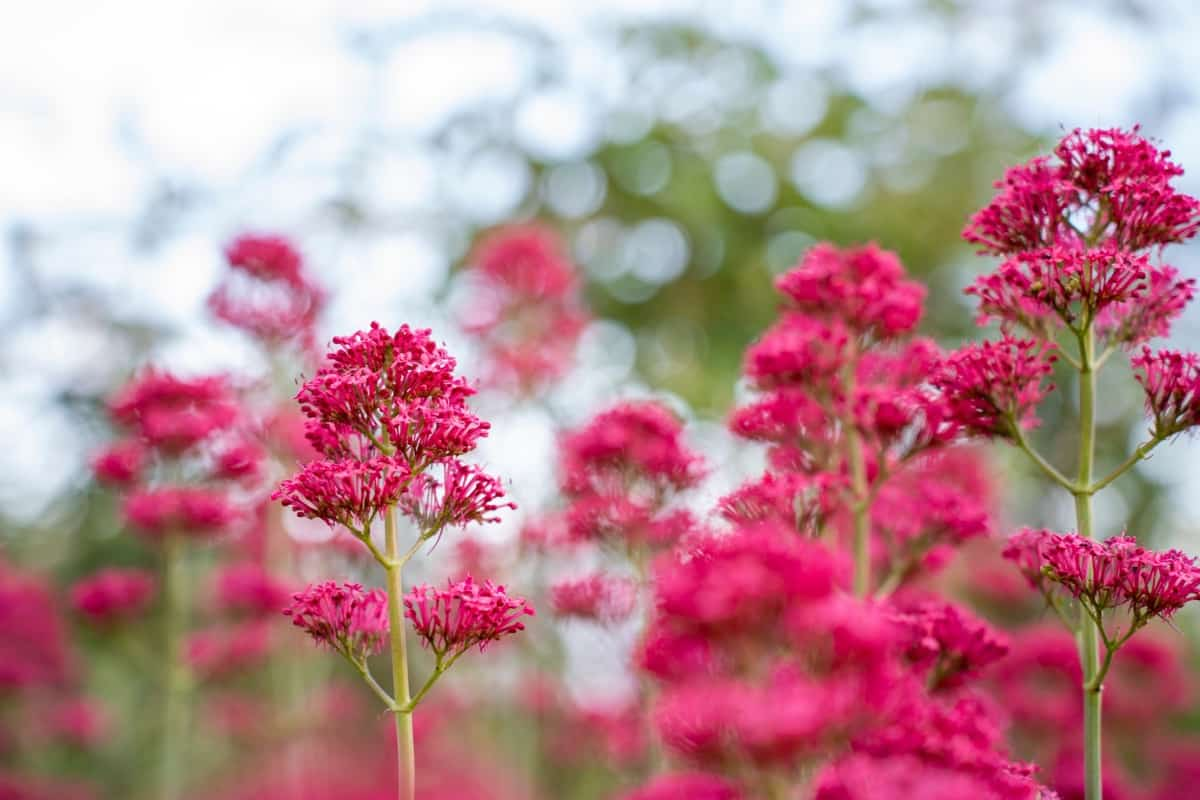Originally from Mediterranean Southern Europe, Northwest Africa, and Asia Minor, the hardy plant has now spread to much cooler climates. A slight lignification at the base of the red valerian grows upright, persistent, and herbaceous. The plant grows to a height of 80 cm. The plant has blue-green opposite leaves with a lanceolate to ovoid shape.

In a golden inflorescence, small blossoms stand together between April and October. Autumn is the time when red valerian blossoms turn into fruit. Here are some planting instructions to help you grow and care for your Red Valerian:
How to Grow and Care for Red Valerian
Red Valerian Planting Guide: Tips for Successful Growth
- Red valerian thrives in well-draining soil and full sun. Select a location for planting Red Valerian that receives plenty of sunlight, as this plant needs 6 hours of sunlight per day to grow and flower properly.
- Red valerian prefers slightly alkaline soil with a pH between 6.5 and 7.5. If you have too acidic, mix lime to increase the pH. Additionally, red valerian requires well-draining soil to prevent root rot.
- If soil is heavy, amend it with organic matter such as compost or sand to improve drainage.
- Red valerian can be grown from seeds or cuttings. Plant the seeds in the spring, after the last frost, or in the fall.
- Sow the Red Valerian seeds directly into the soil, about ¼ inch deep and 12 inches apart.
- Water the Red Valerian seeds lightly and maintain the moisture in the soil until the plants have established.
How to Care for Red Valerian: Watering and Soil Requirements
Watering a little bit daily is not as effective as thoroughly soaking the ground every few days. By deep watering, roots grow deeper into the ground, resulting in a stronger, drought-tolerant plant. Dig into the soil and examine it with your finger or a small trowel to check for moisture. If the soil is dry in the first 5-10cm, it is time to water it.
Red Valerian prefers well-draining soil that is slightly alkaline. If your soil is too acidic, you may need to add some lime to balance the pH levels. Red Valerian thrives in soil that is rich in organic matter. Adding compost or well-aged manure to your soil will help provide the necessary nutrients for optimal growth.
Sunlight Needs for Thriving Red Valerian Plants
Red valerian likes the sun as much as many perennial plants do. It is best to choose a location that receives at least six hours of full sunlight each day so that the plant will have lush foliage and abundant blooms. Part shade is tolerated by the plant, but it does best if it is exposed to full sun all day.
Pruning Techniques for Maintaining Red Valerian’s Shape and Health
By removing old flower stems, the plant’s energy is focused on vigorous growth instead of seed production. Pruning should be done throughout the season to remove damaged or discolored leaves or maintain the plant’s size. Pruning plants after September 1st is not recommended. When the first frosts arrive, pruning stimulates tender new, easily damaged growth. Once perennial plants have died to the ground, and they are easily cleaned up by simply cutting them back to about 4 inches above the ground.
Protecting Red Valerian From Pests and Diseases: Prevention and Treatment”
Prevention
- Water your Red Valerian regularly but do not over-water, which causes the roots to rot.
- Keep the area around your Red Valerian free from debris and weeds, as they can attract pests and diseases.
- Use a good quality fertilizer to ensure your Red Valerian is healthy and strong.
Treatment
- Spray the red valerian plants with insecticidal soap or neem oil to treat pests such as aphids, spider mites, and whiteflies.
- If your Red Valerian becomes infected with a fungal disease such as powdery mildew or leaf spot, use a fungicide to treat it.
- If your Red Valerian becomes infected with a bacterial disease such as bacterial leaf spot, use a copper-based fungicide to treat it.
In case you missed it: How to Grow and Care for Red Trumpet Creeper: Planting Instructions

Harvesting Red Valerian Seeds for Propagation
- Wait until the flowers have dried out on the plant. This is usually in the fall after the blooming season has ended.
- Locate the seed pods on the plant. They are initially small and green but will turn brown as they mature.
- Use scissors or pruning shears to cut the seed pods from the plant. Make sure to cut them close to the stem.
- Place the red valerian seed pods in a paper bag or envelope to dry. Label the bag or envelope with the name of the plant and the date you harvested the seeds.
- Leave the bag or envelope in a dry, cool place for several weeks until the pods are completely dry and brittle.
- Once the pods are dry, gently crush them to release the seeds. Be careful not to crush the seeds themselves.
- Store the Red Valerian seeds in a cool and dry spot until you are ready to plant them.
Winter Care for Red Valerian: Frost Protection and Maintenance
Red Valerian is susceptible to frost damage, especially during the cold winter. Covering the plant with mulch or straw to protect the plant from frost. Cover the red valerian plant with a frost cloth or burlap if the temperature drops below freezing is also recommended. This provides an additional protection layer against cold and frost. It is also important to water the plant regularly, especially during dry spells.
Transplanting Red Valerian: Step-by-step Instructions
- Choose the right time: The best time to transplant red valerian is during its dormant season, usually in the late fall or winter. This is when the plant will be less likely to suffer from transplant shock and is not actively growing.
- Prepare the new planting location: Choose a new location for your red valerian that has well-draining soil and also gets full sun or partial shade. Dig a hole slightly bigger than the plant’s root ball.
- Dig up the plant: Use a garden fork to dig around the base of the plant and gently lift it out of the ground. Be careful not to damage the root system.
- Trim the roots: Trim any broken or damaged roots with pruning shears. This will promote new root growth and help the plant establish itself in its new location.
- Plant the red valerian: Place the plant in the hole and backfill with soil, ensuring to firm the soil around the plant. Water the plants thoroughly to settle the soil and remove any air pockets.
- Water regularly: The red valerian regularly keeps the soil moist but not waterlogged. This will help the plant establish itself in its new location.
Encouraging Abundant Red Blooms in Red Valerian: Fertilizing and Blooming Tips
- Red valerian requires a fertilizer high in phosphorus, which is important for promoting flowering. Using a slow-release fertilizer with an NPK ratio of 5-10-10 is recommended. Apply the fertilizer every two to three months during the growing season.
- Red valerian prefers well-draining soil, so make sure not to overwater it. Water it deeply once a week or whenever the top inch of the soil feels dry.
- Regular pruning can also help encourage more blooms. Deadhead the faded flowers to promote the growth of new buds and remove any dead or diseased branches.
Common Issues in Red Valerian Care: Troubleshooting and Solutions
Poor Soil Quality: Red Valerian thrives in well-draining soil with a slightly alkaline pH. If the soil quality is low, the plant may suffer from stunted growth and yellowing leaves. Add vermicompost or well-aged manure to the soil to improve soil quality and ensure proper drainage.
Pests and Diseases: Red Valerian is relatively pest and disease-resistant but may encounter issues such as aphids, spider mites, or powdery mildew. Spray these plants with neem oil or insecticidal soap to control aphids and spider mites. For powdery mildew, remove infected leaves and avoid overhead watering.
In case you missed it: California Red Sheep Facts: Characteristics, Uses, and Origin

Lack of Sunlight: Red Valerian requires full sun to thrive. If the plant is not getting enough sunlight, it can lead to stunted growth and reduced flowering. The solution is to move the plant to a sunnier location.
Conclusion
Following these instructions, you can easily grow and care for Red Valerian. Enjoy the beautiful blooms and the sweet fragrance that this plant has to offer.
- Feed Your Flock for Less: Top 10 Tips to Save on Chicken Feed
- Ultimate Guide to Ossabaw Island Hog: Breeding, Raising, Diet, and Care
- Hatching Answers: The Top 10 Reasons Your Chickens Aren’t Laying Eggs
- Eggs and Economics: Breaking Down the Cost of Raising Backyard Chickens
- Defend Your Greens: Proven Methods to Keep Iguanas Out of Your Garden
- Ultimate Guide to Cinnamon Queen Chicken: A Comprehensive Guide for Beginners
- Ultimate Guide to California Tan Chicken: Breeding, Raising, Diet, Egg-Production and Care
- Ultimate Guide to Marsh Daisy Chicken: Breeding, Raising, Diet, and Care
- 10 Types of Chicken Farming Businesses You Can Start for Profits